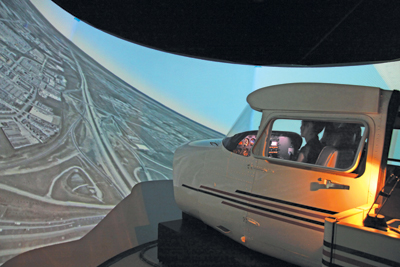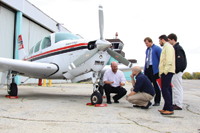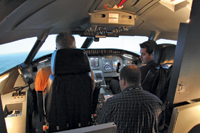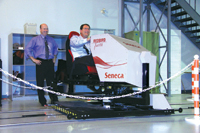
News
Ahead of the curve
When Transport Canada stopped delivering Flight Instructor Refresher
Courses in 2007, Seneca College was the first to step up to the plate to
fill the gap. Wings associate editor and Seneca grad Andrea Kwasnik
visited her alma mater to see firsthand how Seneca is keeping Canada’s
instructors on top of their game.
July 7, 2011 By Andrea Kwasnik
When Transport Canada stopped delivering Flight Instructor Refresher Courses in 2007, Seneca College was the first to step up to the plate to fill the gap. Wings associate editor and Seneca grad Andrea Kwasnik visited her alma mater to see firsthand how Seneca is keeping Canada’s instructors on top of their game.
After an 18-year absence, stepping back into Seneca College’s hangar at the Toronto Buttonville Municipal Airport brought back instant memories of my years in the Aviation and Flight Technology (AFT) program – the intense training, the demanding course curriculum, the camaraderie, and above all, the professionalism of the flight instructors.
The AFT program left an indelible mark on me and on my fellow graduates, and for those of us who went on to flight instructing, shaped the way we taught our own students. Returning to the Buttonville hangar north of Toronto to take part in Seneca’s Flight Instructor Refresher Course (FIRC), it was clear by the end of the day of lectures and group discussion, hangar workshops, and hands-on simulator time, that Seneca has added a very unique and worthwhile course to its roster. By offering the instructor community a chance to learn new techniques, refresh old knowledge and skills, and share best practices with instructors from across Canada, Seneca is advancing industry safety by raising the bar on professional development.
 |
| Hands-on simulator time gives participants a chance to review and discuss teaching methods and techniques. Photo: Alex Salagean, Seneca College. Advertisement
|
A vital part of our industry
It’s hard to deny pilot competency is the key to flight safety. And the training system that produces pilots and ensures they remain competent is a cornerstone of Canada’s aviation infrastructure. Therefore, as the face of training, flight instructors play a pivotal role in industry safety by shaping the way students acquire knowledge, form attitudes and, most importantly, develop decision-making skills. Equally important, then, is the continuous improvement of instructors to ensure they deliver the safest and most effective instruction possible.
Gary Anderson is an Air Canada pilot and instructor in its training department. A graduate of Seneca’s aviation program in 1993, he has remained closely connected to the college throughout his career and is currently a professor and flight instructor in the Bachelor of Applied Technology-Flight degree program. An instrumental part of the refresher course, Anderson maintains it’s vital for instructors to seek additional training on a regular basis because the current system makes instructors prone to complacency.
“As instructors, we often work very independently and tend to focus on areas that we see as needing attention,” he says. “Often these points are misaligned with what the industry and safety data are telling us is important . . . it’s difficult to keep abreast of the latest changes from just reading about it on our own.”
As of September 2010, there were more than 3,000 instructor ratings in force in Canada, 2,000 of which were in the aeroplane category. In order to earn a flight instructor rating, a pilot must have a Commercial Pilot’s Licence, complete at least 55 hours of combined classroom and dual flight training with a Class I instructor, and then pass a written test and a flight test with a Transport Canada inspector or pilot examiner. Because the instructor rating is based on a class system, a new instructor is granted a Class IV instructor rating, and as he or she gains more experience and qualifications, is granted additional privileges as a Class III, II or I.
 |
|
| Aircraft maintenance engineer Jake Branch discusses a safety briefing with course participants at one of Seneca’s Beechcraft Bonanzas. Photos: Alex Salagean, Seneca College. |
But how well does the instructor community continue to develop instructors after their initial training? Often a pilot trains to become a flight instructor at a flight training unit (FTU), and is subsequently hired on by the same FTU to join the ranks of its flight instructors; the teaching methods and culture of the school have become engrained. But what if poor habits or shortcuts are picked up during the instructor rating? And after several years of teaching, can an instructor become complacent or stop developing his or her own skills and instructional techniques? Are there gaps in knowledge that have gone unchecked for years?
Seneca FIRC manager and Class I Flight Instructor, Greg LeBlanc, joined the college’s instructing team in 2005 and is a First Officer on the E190/E175 at Air Canada.
“Many other professionals in our country attend courses, workshops and seminars as part of their professional development,” LeBlanc says. “For instructors upgrading from a Class III to a Class II or Class I, there are no courses or ground school requirements prior to the upgrade flight test . . . our goal is to provide flight instructors with the same type of opportunity as other professionals. There has been a big void in this area.”
As airline pilots, both Anderson and LeBlanc are quite familiar with the rigorous training requirements that are in place to ensure they remain proficient and competent. According to Anderson, most airlines follow a similar footprint of pilot training involving either a six-month Pilot Proficiency Check (PPC), or an eight-month Advanced Qualification Program (AQP) cycle that involves many hours of simulator training, testing and evaluations. On top of this, there is annual recurrent ground school training on topics such as winter operations and crew resource management (CRM). Although not mandated like the airlines, flight schools should encourage their instructors to exercise their due diligence as professionals, to “sharpen their own saws” and keep on top of training approaches.
“Regular training helps remind us that although we are comfortable teaching what we know, there is always more to learn and new ways to improve . . . it’s about lifelong learning,” says Anderson. “Instructors that don’t have this perspective are often left behind when there are paradigm shifts in technology (such as simulation and glass flight decks) or training approaches (for example, competency-based or student-centred learning). Seeking professional development training pushes us out of our comfort zone and challenges and energizes us to improve our skills.”
Seneca raises the bar
When Transport Canada stopped delivering Flight Instructor Refresher Courses in 2007, it granted the flight training industry authority to conduct its own courses under General Aviation Advisory Circular (GAAC) 421-001. Seneca College was the first institution to be approved by Transport Canada as an authorized FIRC provider and ran its first course in April 2007.
Instructing with Seneca College since 1996, Mary Norman was instrumental in developing Seneca’s FIRC. “Our first priority was to meet the requirements set out by Transport Canada,” she says. “But we also wanted to take advantage of our simulators as training aids, and, of course, our staff with a wide variety of backgrounds and skills, to present a refresher course that was dynamically new and different.”
With sharing best practices top of mind, safety has been integrated into every aspect of the course. Whether working directly with AMEs in the hangar, participating in class discussions and lectures, or flying the simulators, course participant involvement is key and an open mind critical. According to the FIRC instructors, often a perspective can change just by listening and watching others, which in turn helps instructors emphasize the key areas to improve in their own teaching back at home.
“All topics on the agenda lend themselves the opportunity to discuss safety – whether it pertains to a specific exercise, pilot decision-making, or scenario-based training, managing risks, etc. The attendees are exposed to such a wide variety of topics, they are able to participate in many more discussions regarding safety than they would by just doing a renewal with a pilot examiner,” adds Norman. (As with instrument ratings and pilot proficiency checks (PPCs), instructor ratings must be renewed with Transport Canada at various intervals, depending on the level of skill and experience of the instructor).
There are currently three other Transport Canada authorized FIRC providers across Canada – Allied Wings, Aviation Solutions and NavPath Aviation Ltd. – and TC provides information on course opportunities on its website (www.tc.gc.ca) under flight training.
Back to basics
Under the direction of Lynne McMullen, chair of Seneca’s School of Aviation and Flight Technology, and former CFI, the FIRC is offered twice a year. It takes place at Seneca’s newest campus in Markham, Ont., and at the nearby Buttonville airport. Experienced flight instructors, pilot examiners and industry experts lead participants through three days of professional development and comprehensive learning, with an optional fourth day for a more in-depth insight into industry-leading research, development and training. The in-class topics are relevant and timely, and include teaching situational awareness, threat and error management, instructor supervision, SMS, Canadian air regulations made simple for instructors, and flight training challenges.
 |
|
| Regular training keeps instructors on top of paradigm shifts in technology and training approaches.
|
An essential part of Seneca’s course mandate is to get input from key industry partners. Audra Oakes, Civil Aviation Safety Inspector, Aviation Enforcement, with Transport Canada, has participated in the program since March 2010. Providing a thought-provoking refresher on the Canadian Aviation Regulations (CARs), she reminds instructors that regulations are made not only for the adherence of pilots, but also to protect the unsuspecting public that fly with them. Members of the general public have little knowledge of how to judge what is safe in an aircraft or the level of competence of a pilot.
Building on the theme, Brian Carlick, an instructor for 22 years who has taught at Seneca for 10, says students in flight training are also part of the “unsuspecting public,” and while training, are unaware of what they don’t yet know. “Skills alone are of little use to a student who doesn’t know why it is done that way or what issues or dangers he is avoiding in the process,” he says. “Instructors need to think of the passengers their students will carry in the near future.”
Understanding how a student will connect to the information being taught is so important, reinforces Carlick. “Students of this generation are too familiar with video games, TV screens, iPods, and cellphones – they tend to fixate on instruments,” he says. “We need to instil the importance of an ‘eyes up’ culture in all our lessons.”
Stressing that instructors tend to put too much emphasis on getting their students to achieve a certain level of skill or knowledge, Carlick leads a session about shifting the point of emphasis in teaching from skills improvement to decision-making.
“Teaching skills in the framework of decision-making, rather than the other way around, gives us a more effective and inherently more basic framework in which to teach – this is a revelation for some instructor participants,” he says. Being immersed in learning with a group of qualified instructors for three days, he adds, reinforces a deeper pattern and common thread of decision-making as a key part of each lesson. “That is a “best practice” you feel in the group and that’s difficult to put in a handbook or to discover in one-on-one teaching.”
The value of the simulator
As the training world evolves, instructors need to adapt to the changing environment by keeping on top of new techniques, for their own professional credibility, and more importantly, for safety. For example, the use of flight training devices (FTDs), or simulators, is becoming an increasingly more efficient and effective method of training. It allows instructors to create a variety of scenarios and conditions that can’t be taught in an actual aircraft, making it a greener, safer and more cost-effective way to teach. And advances in aircraft systems, new cockpit technologies, the modernization of our air traffic system, and emerging new concepts in flight training, such as the multi-crew pilot
licence (MPL), are demanding newer, safer and smarter ways
of training.
To that end, Seneca has incorporated hands-on simulator time, during which scenario-based training is covered in several of its sims, including the Redbird X-wind trainer, Beechcraft Baron, Cessna 172S, and Bombardier CRJ. According to LeBlanc, the time spent in the simulators reinforces how to use these tools to teach anything from basic flying to the advanced techniques used in multi-crew training in a simulated airline environment.
In fact, Seneca is partway through a five-year research project that is looking at the viability of allowing students more simulator training time to acquire some of the roughly 200 flight training hours in the Commercial Pilot Training requirements. Supported by a $2.3 million grant from the Natural Sciences and Engineering Research Council’s (NSERCs) College and Community Innovation Program, Seneca is partnering with aviation hardware and software companies, Transport Canada, aviation colleges, and flight-training schools. (Visit www.wingsmagazine.com to read more about this industry-leading research project: “Innovation through simulation” in our web exclusives section).
Taking the message back home
Validating the usefulness of the simulators is Class I instructor Deanna Wiebe, chief flight instructor at Calgary’s Bissett School of Business, Mount Royal University. Wiebe recently travelled to Ontario to participate in an FIRC.
“Having the chance to use the crosswind simulator was invaluable,” Wiebe says. “Actually being able to experience it for myself, and not just hear about it, showed me the amazing training opportunities it has [see “The Redbird has landed,” pg. 44]. Teaching a student how to manage crosswinds is challenging in the aircraft as there is so little time in the landing phase for a student to practise their skills . . . I was so impressed with the simulator that I brought the information back to Mount Royal University and we are looking at getting one as well.
“One of the most useful aspects of the course was that we were able to discuss the gaps and problems we see with flight training, both from our own experiences and from flight test results. We were guided into discussion on how to improve, not just focus on the fact that things need to change. It was really emphasized that we are the ones doing the training, so if we don’t like the results, we need to change what we’re doing.
“Another useful part of the course was the ‘Threat and Error Management’ sessions. I see a huge value in bringing that back to my program to improve awareness and safety. There is so much more to flying an aircraft beyond the flying skills, and that’s what this session focused on.”
Course participant Jeremy Holdsworth, now a Class II instructor at Canadian Flight Academy in Oshawa, chose to renew his Class III instructor rating by taking Seneca’s FIRC rather than a Transport Canada flight test. Beyond the value of collaborating with like-minded professionals with the common goal of improving safety in the industry, Holdsworth found the networking possibilities invaluable.
“All of the presenters had fantastic communication skills, and it was beneficial to be able to bounce ideas off each other in the group settings,” he says. “It really reinforced that there is more than one right way to do something.”
A worthwhile investment
An early 1900s U.S. Supreme Court justice and advocate of progressive thinking, Oliver Wendell Holmes Jr., said, “Man’s mind stretched to a new idea never goes back to its original dimensions.” By offering instructors a chance to learn new techniques, and collaborate with industry colleagues on strategies, safety systems and best practices, Seneca is upping the ante on
industry safety and keeping Canada’s flight instructors on top of their game.
Seneca’s next FIRC will be held Oct. 24-26, with an optional fourth day of professional development on Oct. 27. Find out more about the course at www.senecac.on.ca/school/aviation/irc/.
The Redbird has landed
Landing a plane in the presence of a crosswind is one of the most challenging and potentially dangerous manoeuvres a pilot can perform. And since the early days of powered flight, pilots have struggled to learn proper crosswind landing techniques. In the safety of the hangar, the Redbird Xwind simulator allows students to master crosswind landings without risking an accident. Instructors can call up any scenario and provide students with the practice they’ll need to better handle the real event when it may occur. The Redbird Xwind utilizes a unique motion platform that simulates the forces felt during those crucial five seconds during a crosswind landing in which the plane must interact with the ground. The platform delivers 60 degrees of roll, 90 degrees of yaw, and 14 feet of lateral drift. This motion, along with the proper peripheral visual cues, strengthens a pilot’s skills to better recognize alignment, bank angle, and lateral position over the centreline. In addition to being a valuable teaching tool, the Redbird is being used in Seneca’s five-year research project: Innovation Through Simulation: Enhancing Canada’s Next Generation of Pilots. |
